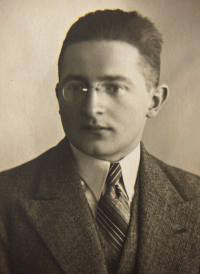
In the 1920s and 1930s, new and sophisticated cipher machines were developed to keep secret messages that were sent over radio. Radio was the best way to communicate quickly over long distances, but anyone could listen in to transmissions. One of the new cipher machines introduced in the 1920s was the German Enigma cipher machine, first introduced for civilian use in 1923.
The Enigma machine was one of the first machines to use moving rotors and electric circuits to encrypt messages. In the late 1920s, more sophisticated versions of Enigma became Germany’s main military encryption device. Due to the massive number of possible encryption settings, the German military believed Enigma to be practically unbreakable.

One of the first countries to try to break into Enigma was Poland. After the First World War, Poland had regained its independence and quickly realised the importance of codebreaking during the Polish-Soviet War of 1919-1921 when Józef Piłsudski, Polish Head of State in the 1920’s and 1930’s, used intelligence provided to him by a very successful Polish Army’s ‘Cipher Section’ to gain the upper hand over the Russians.
Hundreds of enemy ciphers were broken by a team that included army lieutenant Jan Kowalewski and three professors of mathematics: Stefan Mazurkiewicz, Wacław Sierpiński and Stanisław Leśniewski. This ultimately led to the Polish success in the Battle of Warsaw – ‘an enormous defeat’ in the words of Vladimir Lenin.

This Polish victory was built upon – the Polish Army ‘Cipher Section’ became the ‘Cipher Bureau’ and began recruiting civilian mathematicians to study and break the new mathematically complex cipher systems being developed in the 1920s.
In the early 1930s, they hired and trained new mathematicians including Marian Rejewski, Jerzy Różycki, and Henryk Zygalski to generate new code and cipher systems and to study and break enemy code and cipher systems. They weren’t the only country interested in being able to decrypt and read German forces’ communications, which could provide crucial secret information and offer a vital military advantage.

Polish, French and British codebreakers had all begun attempting to break Enigma in the 1930s. However, the Poles were the furthest ahead in part because they were able to intercept Enigma messages as soon as the German military started to use. Thousands of miles away, Britain could not intercept Enigma messages until the Spanish Civil War between 1936 and 1939.
Between 1932 and 1938, mathematicians at the Polish Cipher Bureau broke the Enigma cipher. Polish codebreaker Marian Rejewski reverse-engineered the inner workings of a military Enigma machine and produced a copy referred to as a ‘Polish Enigma Double’ manufactured. We have one of two surviving examples on display in the Top Secret exhibition. Rejewski calculated its wiring by mathematical analysis of encrypted messages, knowledge of a less secure commercial version of the Enigma machine and secret information provided by the French military.
With a looming war on the horizon, and aware that further success depended on international cooperation and money, the Poles decided to share their success, tools and knowledge with other Allies including British codebreakers from Bletchley Park. In July 1939, Polish codebreakers shared everything they knew about Enigma with their British and French counterparts at a secret meeting in woods near Warsaw, just before Germany invaded Poland and the Second World War began.

Their help was vital for the codebreakers at Bletchley Park. It was the groundwork on which Bletchley Park codebreakers built their efforts to decrypt Enigma messages. Staff at Bletchley Park, including Alan Turing and Gordon Welchman, developed a scaled-up electromechanical version of the hand-operated Polish Bombe machine, a purpose-built machine used to break into German Enigma traffic.
This painstaking work, the sheer power of minds, and international co-operation of British and Polish codebreakers enabled the Allies to routinely break into Enigma from early 1940 onwards and contributed to Allied success in the war.
Further reading
X, Y & Z: The Real Story of How Enigma Was Broken by Dermot Turing (2018).
What’s the context? Polish cryptologists reveal they have cracked the Enigma code, 26 July 1939 by Gill Bennett, formerly Chief Historian of the Foreign and Commonwealth Office and Senior Editor of the FCO’s official history of postwar foreign policy.
British Library European studies blog: Polish mathematicians and cracking the Enigma by Magda Szkuta, Curator of East European Collections
IEEE Milestones: First Breaking of Enigma Code by the Team of Polish Cipher Bureau, 1932-1939 and Code-breaking at Bletchley Park during World War II, 1939-1945
This was originally posted in support of our Top Secret: From Ciphers to Cyber Security exhibition that was open from 10 July 2019 – 23 February 2020.
